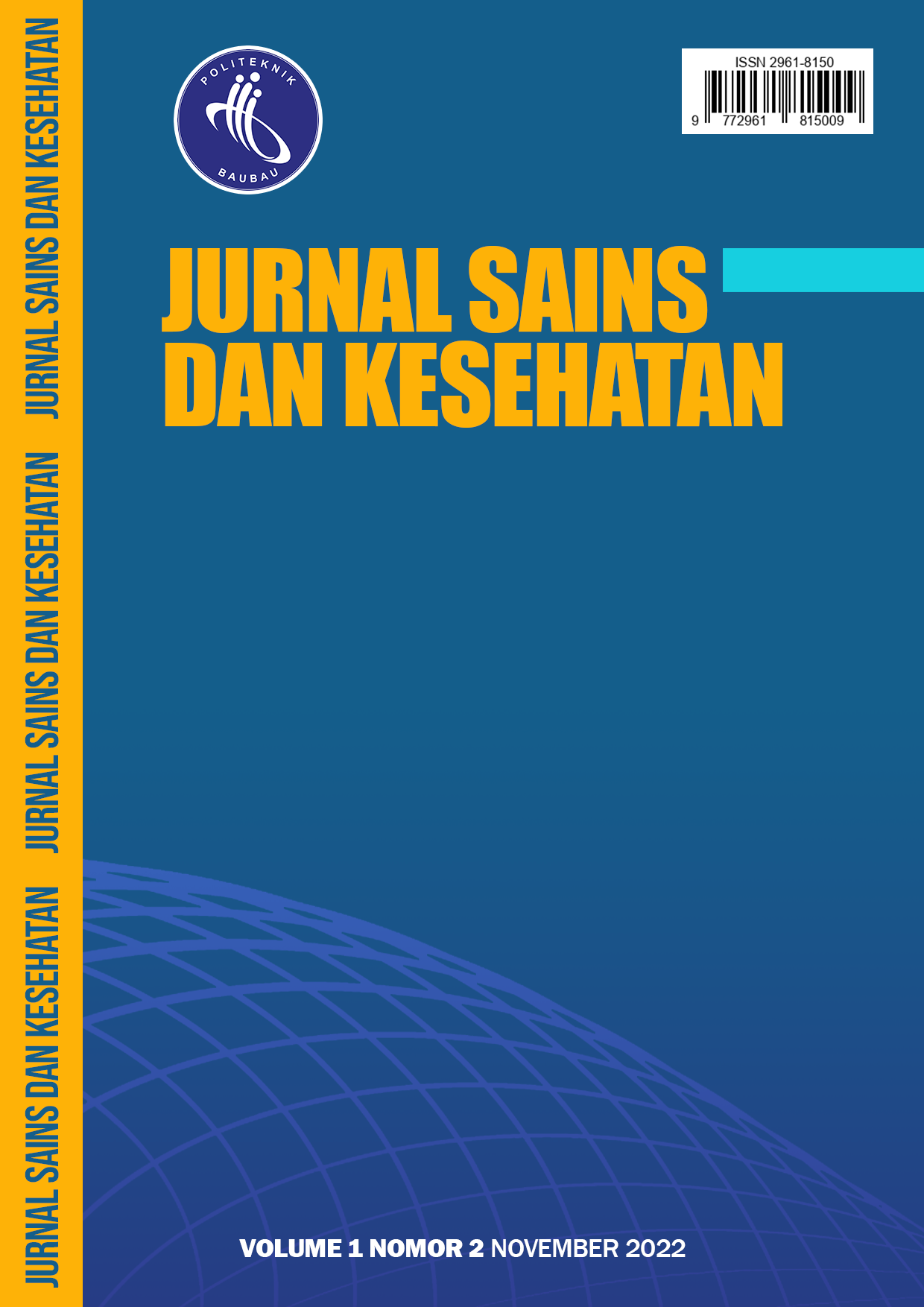Kejadian Diare Bayi 1−12 Bulan dari Perilaku Hidup Bersih dan Sehat (PHBS) Ibu
Main Article Content
Abstract
Diarrhea is still one of the main causes of illness and death in almost all geographic areas in the world that can affect all age groups, but the highest morbidity and mortality occurs at the age of infants and toddlers. The death figures released by UNICEF last August 2018 show that globally around 2,000 children under the age of five die every day from diarrheal diseases. Of these, most or about 1,800 children per day die from diarrheal diseases due to lack of clean water, sanitation and basic hygiene. This study aims to determine the relationship between Clean and Healthy Behavior and the incidence of diarrhea in infants 1-12 months at the West Passi Health Center. This type of research is quantitative. The research design is descriptive analytic using cross sectional, where the type of research that emphasizes the time of measurement of data is the independent variable of clean and healthy living behavior and the dependent variable is the incidence of diarrhea. Research Results: Based on the results of statistical tests, p value = 0.009, so it can be concluded that there is a relationship between Clean and Healthy Life Behavior and the incidence of diarrhea in infants 1-12 months old at the West Passi Health Center. The dominant mother's PHBS is good and generally does not have diarrhea. Conclusion and Suggestion: For Puskesmas institutions, especially the organizers of the MCH program, to further improve health services for mothers and children to reduce the incidence of infant and child diarrhea.
Article Details
References
Anggraini, M. T., Aviyanti, D., & Saputri, D. M. (2014). PHBS yang Buruk Meningkatkan Kejadian Diare. Jurnal Kedokteran Muhammadiyah, 3(1), 1–6.
Djaja, S., & Sulistiyowati, D. N. (2014). Pola Penyebab Kematian Kelompok Bayi Dan Anak Balita, Hasil Sistem Registrasi Kematian di Indonesia Tahun 2012 Cause of Death Patterns of Infants and Children Under 5 Years, the Result of Indonesia Mortality Registration System on 2012. Jurnal Ekologi Kesehatan, 265–272.
Fuady, I., Prasanti, D., & Indriani, S. S. (2020). Penerapan teori plan behavior: faktor yang mempengaruhi niat perilaku hidup bersih dan sehat. Jurnal Berkala Kesehatan, 6(1), 24–30.
Indah, M. F., Fahrurazi, F., & Husna, N. (2017). Kejadian Diare Pada Balita Ditinjau Dari Perilaku Hidup Bersih Dan Sehat (Phbs) Tatanan Rumah Tangga Di Kabupaten Hulu Sungai Utara Kalimantan Selatan. Jurnal Publikasi Kesehatan Masyarakat Indonesia, 4(2), 0–1. https://doi.org/10.20527/jpkmi.v4i2.3844
Isnaniar, Y. I. L. (2017). Hubungan Perilaku Hidup Bersih dan Sehat (Phbs) Ibu dengan Kejadian Diare di Puskesmas Garuda Pekanbaru. Jurnal Photon, 8(1), 155–160.
Jamil, L. (2019). Hubungan antara Perilaku Hidup Bersih dan Sehat (PHBS) Tatanan Rumah Tangga dengan Kejadian Diare pada Balita. ARKESMAS (Arsip Kesehatan Masyarakat), 4(1), 125–133. https://doi.org/10.22236/arkesmas.v4i1.3144
Kusumawardani, L. H., & Saputri, A. A. (2020). Gambaran pengetahuan, sikap dan keterampilan perilaku hidup bersih sehat (phbs) pada anak usia sekolah. Urnal Ilmiah Ilmu Keperawatan Indonesia, 10(2), 82–89.
Natsir, M. F. (2019). Perilaku hidup bersih dan sehat (PHBS) pada tatanan rumah tangga masyarakat desa parang baddo. Jurnal Nasional Ilmu Kesehatan, 1(3), 54–59.
Radhika. (2019). Hubungan Tindakan Cuci Tangan Pakai Sabun Dengan Kejadian Diare Pada Balita. Medical Technology and Public Health Journal, 1(16), 24.
Rosiska, M. (2021). Hubungan Perilaku Hidup Bersih dan Sehat (PHBS) Ibu dengan Kejadian Diare pada Anak Balita di Puskesmas Sungai Liuk. Jurnal Ilmu Kesehatan Dharmas Indonesia, 1(1), 1–23.
Siregar, T., & Febriani, N. (2020). Pengaruh Health Education Terhadap Kepatuhan Perilaku Hidup Bersi Sehat (PHBS) Warga. Jurnal’Aisyiyah Medika, 5(1).
Suhendar, I., Rosidin, U., & Sumarni, N. (2020). Pendidikan Kesehatan Tentang Hidup Bersih dan Sehat di Lembaga Kesejahteraan Sosial Anak Al-Amin Garut. JPKMI (Jurnal Pengabdian Kepada Masyarakat Indonesia), 1(3), 135–145.
Ummah, W., & Putri, S. I. (2020). Hubungan Perilaku Hidup Bersih dan Sehat (PHBS) Tatanan Rumah Tangga dengan Kejadian Diare pada Balita di Polindes Palaan Ngajum. Jurnal Bidan Komunitas, 3(1), 9. https://doi.org/10.33085/jbk.v3i1.4530
Widiantoro S, Budiarti, H. (2013). Perilaku Hidup Bersih Dan Sehat ( PHBS ) Dengan Kejadian Diare Pada Anak Sekolah Dasar. 01(01), 40–47.
Yuniar, W. P., Khomsan, A., Dewi, M., Ekawidyani, K. R., & Mauludyani, A. V. R. (2020). Hubungan antara Perilaku Gizi dan Perilaku Hidup Bersih dan Sehat (PHBS) dengan Status Gizi Baduta Di Kabupaten Cirebon. Amerta Nutrition, 4(2), 155.

